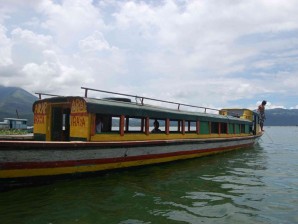Saving Lake Buhi’s ‘sinarapan’

NAVIGATIONAL areas where passenger boats serving 10 villages, like this one, will be the first to be cleared of fish cages in the Lake Buhi. JUAN ESCANDOR JR.
BUHI, CAMARINES SUR – Starting June 1, the municipality of Buhi in Camarines Sur will dismantle fish cages that choke its lake, hoping to attract anew the “sinarapan,” considered the world’s smallest fish.
Mayor Rey Lacoste said the effort would mean the loss of a huge amount of revenue from business permits and other local taxes paid by fish pen owners breeding “tilapia” in the Lake Buhi.
But, he said, the need to preserve Buhi and what remained of the indigenous sinarapan (Mistichthys luzeninses) far outweighed the gains that tilapia breeders had brought to the local economy.
The fish cages occupy about 70 percent of the 1,600-hectare lake. Under Republic Act No. 8550, or the Fisheries Code of 1998, only 10 percent of lake area should have been used for aquaculture and other forms of development, Lacoste said.
Regulating use
“The positive environmental impact is projected to increase over time if we could regulate the use of the water resources. We are determined to dismantle the fish cages that overcrowd the lake,” the mayor said.
Sinarapan can be found only in Lake Buhi and two other smaller lakes which were geologically formed by a big eruption centuries ago which blew away the side of Mount Asog, 500 kilometers south of Manila.
The freshwater fish species (at least 10 pieces can fill up a thumbnail and is like a transparent tiny anchovy with an average length of 12.5 millimeters), is local delicacy best made into omelette, cooked in lemon and tomato, or dried and fried.
Overfishing
Once abundant and commercially harvested in Buhi, the sinarapan population has been depleted due to overfishing in the 1980s, and aggravated by fish cage congestion.
It can only be found now in Lake Manapao, a smaller lake of Buhi town, which was declared a sinarapan sanctuary.
A study done on Nov. 2, 2010, by a technical team of the provincial government showed that the lake was choking from “depletion of oxygen, pollutant toxins, natural toxins and diseases” caused “directly and indirectly from aquaculture activities.”
The level of ammonia, acidity, nitrite oxygen and alkalinity were beyond the tolerable level, triggering a massive fish kill from Oct. 31 to Nov. 1, 2010. Almost 90 percent of tilapia grown in the lake was destroyed, causing some P80 million in losses to breeders.
At present, there are 1,037 fish cage operators who own 13,319 fish cages that occupy 1,120 ha of the 1,600-ha lake, said Lake Buhi Development Office head Ronelo Leal.
Lacoste said the first to go are fish cages built on navigational areas and declared fish sanctuaries. Later, they will dismantle other fish cage structures that occupy about 160 ha of Lake Buhi.
He said he had stopped giving permits to renew fish cage operations, as well as restocking of fish cages since February.
Big business
Raising tilapia in Buhi is big business, with operators harvesting an average of 10,000 kilograms of fish for markets in Bicol, Quezon province and Metro Manila, he said.
He cited records showing that in 2008 and 2009, tilapia breeders were raking in P18 million a month in profits, but the municipality earned only P201,146 and P93,034 from the industry, respectively.
The LGU collects P0.50 per square-meter use of lake water for fish cage operation, and a P200 fee per operator annually.
Vice Mayor Omar Mercurio sees the move to dismantle the fish pens as “madugo (bloody),” with many operators secretly restocking their pens.
The nonrenewal of permits caused the price of tilapia to soar to P100 per kilo from the previous P60, he said.
In the late 1980s, Mercurio said that the municipal administrations had cashed in on fish cage operations to the detriment of the lake’s carrying capacity.
A 1986 ordinance that regulated the operations was also disregarded, he said. Under that law, fish pens should have been allowed in only 282.6 ha of the lake area, he added.














